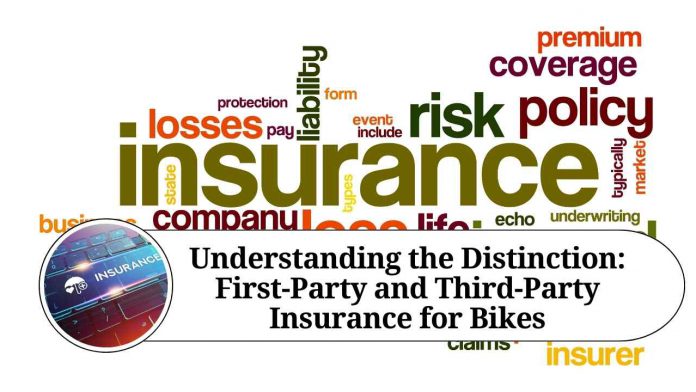Introduction
When it comes to insuring your bike, it’s essential to understand the different types of insurance coverage available. Two common categories you’ll encounter are first-party insurance and third-party insurance. While both serve to protect you and your bike, there are significant differences between the two. In this blog post, we will delve into the dissimilarities between first-party and third-party insurance for bikes, enabling you to make an informed decision about the coverage that best suits your needs.
First-Party Insurance: Protecting Your Own Bike
First-party insurance, also known as comprehensive insurance or own-damage insurance, focuses on providing coverage for your own bike in the event of an accident, theft, or damage. It is an optional form of coverage that goes beyond the minimum requirements mandated by law. Let’s take a closer look at some key features and benefits of first-party insurance:
- Protection Against Accidents: First-party insurance safeguards your bike against damage caused by accidents, whether it’s a collision with another vehicle, hitting an object, or overturning. The insurance company will cover the cost of repairs or provide reimbursement for the loss suffered.
- Coverage for Theft: If your bike is stolen, first-party insurance will compensate you for the loss based on the value of your bike at the time of theft, subject to policy terms and conditions.
- Damage Due to Natural Disasters: Comprehensive insurance typically includes coverage for damage caused by natural calamities such as floods, earthquakes, hurricanes, or storms.
- Financial Assistance for Vandalism: In case your bike falls victim to vandalism, first-party insurance can help cover the costs of repairs or replacement.
- Personal Accident Cover: Some first-party insurance policies may also offer personal accident cover, providing compensation for medical expenses, disability, or loss of life resulting from an accident involving your bike.
Third-Party Insurance: Protecting Others Involved
Third-party insurance, also known as liability insurance, primarily focuses on protecting individuals other than yourself who may suffer injury or property damage due to an accident involving your bike. This type of insurance is mandatory in most jurisdictions, and riding without it can lead to legal consequences. Here are some key aspects of third-party insurance:
- Liability Coverage: Third-party insurance covers the legal liability you may incur for causing bodily injury or property damage to a third party. It ensures that if you are at fault in an accident, the injured party’s medical expenses, vehicle repair costs, or other damages are taken care of.
- Legal Protection: In addition to financial coverage, third-party insurance often provides legal defense if a lawsuit is filed against you by the injured party.
- Legal Compliance: In many countries, third-party insurance is a legal requirement for riding a bike on public roads. It ensures that all road users have a level of financial protection in case of accidents.
- Limited Coverage: It’s important to note that third-party insurance does not cover any damage to your own bike or personal injuries you may suffer in an accident. It solely focuses on providing compensation to third parties affected by the accident.
Choosing the Right Insurance Coverage
When deciding between first-party and third-party insurance for your bike, several factors come into play. If you are concerned about protecting your bike against theft, damage, or accidents, comprehensive first-party insurance may be the ideal choice. On the other hand, if meeting legal requirements and protecting yourself from potential financial liabilities resulting from an accident are your primary concerns, third-party insurance is mandatory and should be your focus.
Read more useful content:
Frequently Asked Questions (FAQs)
Q. What is first-party insurance for bikes?
First-party insurance, also known as comprehensive insurance or own-damage insurance, provides coverage for your own bike against accidents, theft, and damage. It goes beyond the minimum legal requirements and is optional.
Q. What does first-party insurance cover?
First-party insurance covers various scenarios, including accidents, collision damage, damage caused by natural disasters, theft, vandalism, and may even include personal accident cover for the policyholder.
Q. What is third-party insurance for bikes?
Third-party insurance, also known as liability insurance, focuses on providing coverage for the injuries and property damage suffered by third parties in an accident caused by you. It is typically a legal requirement in many jurisdictions.
Q. What does third-party insurance cover?
Third-party insurance covers the financial liabilities you may incur if you cause bodily injury or property damage to a third party in an accident. It takes care of their medical expenses, vehicle repair costs, or other damages.
Q. Is third-party insurance mandatory for bike owners?
In many countries, third-party insurance is a legal requirement for riding a bike on public roads. Failing to have valid third-party insurance can result in legal consequences.
Q. Can first-party insurance compensate for damages caused to other people or their property?
No, first-party insurance does not cover damages caused to third parties. It solely focuses on protecting your own bike against various risks.
Q. Can I have both first-party and third-party insurance for my bike?
Yes, you can opt for a combination of both first-party and third-party insurance. This provides comprehensive coverage, protecting your own bike while also meeting legal requirements and protecting other road users.
Q. How can I decide which insurance coverage is best for me?
Your choice of insurance coverage depends on your specific needs and priorities. If you want to protect your bike against theft, accidents, and damages, comprehensive first-party insurance is recommended. If legal compliance and protecting yourself from potential financial liabilities are crucial, you must have valid third-party insurance.
Q. Can I upgrade my third-party insurance to first-party insurance later?
Yes, you can generally upgrade your insurance coverage from third-party to first-party insurance by contacting your insurance provider and making the necessary arrangements. However, the availability and conditions may vary depending on your insurance provider and policy.
Q. Are there any additional riders or add-ons available for first-party and third-party insurance?
Yes, both first-party and third-party insurance policies may offer additional riders or add-ons for enhanced coverage. These can include roadside assistance, zero depreciation cover, engine protection, and more. You can discuss these options with your insurance provider and choose the ones that suit your requirements.




















